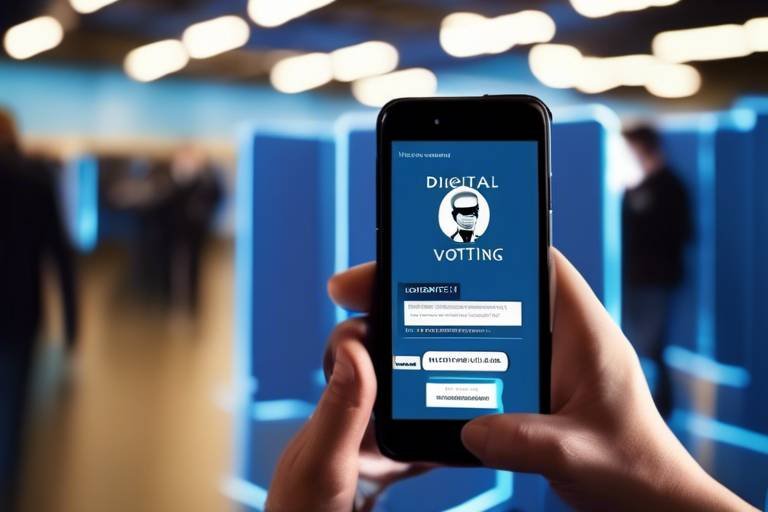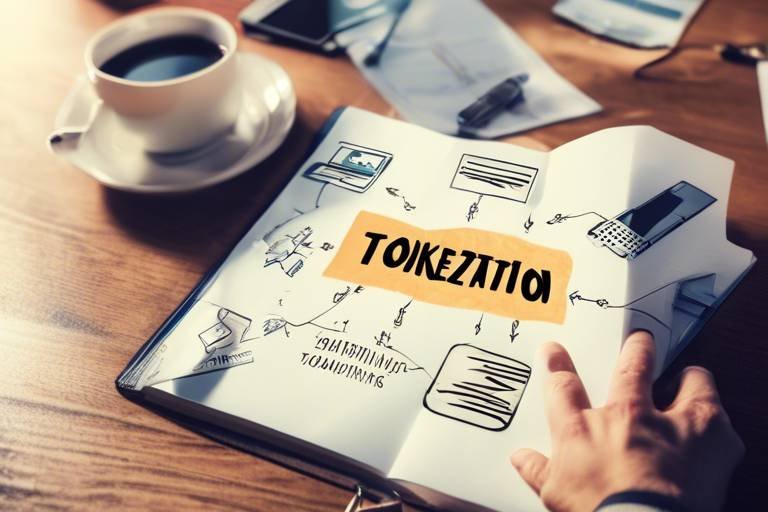The Role of Blockchain in Mitigating Financial Risks
In today's rapidly changing financial landscape, the need for innovative solutions to mitigate risks has never been greater. Financial risks can arise from various sources, including market volatility, credit issues, and operational failures. These risks can lead to significant losses for businesses and individuals alike. Enter blockchain technology, a game-changer that promises to enhance transparency, security, and efficiency in transactions and record-keeping. By leveraging the unique features of blockchain, companies can navigate the murky waters of financial uncertainty with greater confidence.
Imagine a world where every transaction is recorded in a secure, tamper-proof manner, visible to all parties involved. This is the essence of blockchain. It allows for real-time tracking of assets and transactions, significantly reducing the chances of fraud and errors. By decentralizing the control of data, blockchain eliminates the risks associated with a single point of failure. In this article, we will delve into how blockchain can effectively reduce financial risks across various sectors, explore its foundational principles, and highlight real-world implementations that showcase its potential.
The implications of adopting blockchain technology are profound. Businesses can achieve higher levels of accountability and trust, which are crucial in today’s economy. Moreover, the automation of processes through smart contracts can minimize human error, streamline operations, and ultimately lead to cost savings. As we explore the intricate relationship between blockchain and financial risk mitigation, it’s essential to consider both the challenges and opportunities that lie ahead.
- What is blockchain technology?
Blockchain is a decentralized digital ledger that records transactions across multiple computers in a way that the registered information cannot be altered retroactively.
- How does blockchain reduce financial risks?
By enhancing transparency, security, and trust, blockchain minimizes the potential for fraud and errors in transactions.
- What are smart contracts?
Smart contracts are self-executing contracts with the terms directly written into code, allowing for automatic execution when conditions are met.
- Are there any challenges to implementing blockchain?
Yes, challenges such as scalability, regulatory compliance, and integration with existing systems can affect the widespread adoption of blockchain technology.

Understanding Financial Risks
Financial risks are an unavoidable aspect of the business landscape, encompassing a variety of uncertainties that can lead to significant financial loss. These risks can arise from various sources, including market fluctuations, credit issues, operational challenges, and even external factors like political instability. Understanding these risks is crucial for both businesses and individuals, as it enables them to make informed decisions and implement strategies to mitigate potential losses.
At its core, financial risk can be broadly categorized into several key types:
- Market Risk: This refers to the potential losses due to fluctuations in market prices. For instance, stock prices may drop unexpectedly, affecting investors' portfolios.
- Credit Risk: This type of risk arises when a borrower fails to meet their financial obligations, leading to losses for lenders or investors.
- Operational Risk: These risks stem from internal processes, systems, or people. For example, a failure in a company's IT system can disrupt operations and lead to financial losses.
- Liquidity Risk: This involves the inability to convert assets into cash quickly without a significant loss in value, which can be particularly problematic during financial crises.
The implications of these risks can be profound. For businesses, failing to manage financial risks effectively can lead to bankruptcy, loss of reputation, and diminished market share. Individuals, on the other hand, may face personal financial crises, affecting their credit scores and future borrowing capabilities.
Moreover, as we navigate through an increasingly complex financial landscape, the importance of risk management becomes even more pronounced. Companies are now leveraging various tools and technologies to assess and mitigate these risks. However, traditional methods often fall short in providing the transparency and security needed in today’s fast-paced environment.
In summary, understanding financial risks is essential for anyone involved in the financial sector. By recognizing the different types of risks and their potential impacts, businesses and individuals can better prepare themselves to face uncertainties head-on, ultimately leading to more resilient financial strategies.

Blockchain Basics
Blockchain technology is often described as a decentralized ledger that records transactions across a network of computers. But what does that really mean? Imagine a digital notebook that everyone can see, but no one can erase. Each page of this notebook represents a block, and when a page is filled with transactions, it gets linked to the previous page, forming a chain. This is where the term blockchain comes from. Each block contains a list of transactions, a timestamp, and a unique code called a hash that distinguishes it from other blocks.
One of the fundamental principles of blockchain is decentralization. Unlike traditional financial systems that rely on a central authority, such as a bank, blockchain operates on a peer-to-peer network. This means that all participants have access to the same information and can verify transactions independently. This decentralization not only enhances security but also fosters trust among users, as there’s no single point of failure that can be exploited by fraudsters.
Another critical aspect of blockchain is its ability to ensure security. Each transaction is encrypted and linked to the previous transaction, making it nearly impossible to alter any information without the consensus of the network. This level of security is crucial in reducing financial risks as it minimizes the chances of data breaches and fraud. In fact, studies have shown that industries that adopt blockchain technology can experience a significant decrease in fraudulent activities.
Now, let’s talk about smart contracts. These are self-executing contracts with the terms of the agreement directly written into code. Picture this: you want to buy a house. Instead of dealing with a real estate agent and going through a lengthy process, a smart contract could automate the entire transaction. Once the agreed conditions are met, the contract executes automatically, transferring ownership without the need for intermediaries. This not only speeds up transactions but also reduces the risk of human error, making financial dealings more efficient.
Transparency is another game-changer that blockchain brings to the table. Since all transactions are recorded on a public ledger, every participant can view the history of transactions. This level of visibility can significantly mitigate risks associated with hidden information, as all parties can hold each other accountable. For example, in supply chain management, companies can track the origin of products and ensure that they adhere to ethical standards. This transparency builds confidence among consumers and stakeholders alike.
In summary, understanding the basics of blockchain is essential for grasping its potential in mitigating financial risks. With its decentralized nature, robust security features, smart contracts, and transparency, blockchain is not just a buzzword; it’s a revolutionary technology that is reshaping the financial landscape. As we delve deeper into the implications of blockchain in various sectors, it becomes clear that its impact is just beginning to unfold.

Decentralization and Trust
Decentralization is one of the most revolutionary aspects of blockchain technology. Imagine a world where no single entity holds the keys to your financial transactions. Instead, these transactions are spread across a vast network of computers, each maintaining a copy of the entire ledger. This means that the power is in the hands of the many rather than the few, fostering a sense of trust among users. In traditional financial systems, trust is often placed in banks or financial institutions, which can be susceptible to fraud, corruption, or even failure. Blockchain flips this model on its head.
With blockchain, every participant in the network can verify the authenticity of transactions independently. This transparency not only enhances security but also builds confidence among users. For instance, when you send money using a blockchain-based system, you can see the transaction recorded on the public ledger. This is akin to having a group of friends witnessing a handshake deal; everyone knows what was agreed upon, reducing the likelihood of disputes.
Furthermore, the decentralized nature of blockchain diminishes the risks associated with a single point of failure. In traditional systems, if a central authority is compromised, the entire system is at risk. However, in a decentralized network, even if one node goes down, the system remains operational, as other nodes continue to validate and store transactions. This resilience is crucial in mitigating risks, especially in sectors that are heavily reliant on trust.
To illustrate this, consider the following points:
- Reduced Fraud: Since every transaction is recorded and verified by multiple parties, the chances of fraudulent activities decrease significantly.
- Enhanced Accountability: With transparency comes accountability. Users can trace transactions back to their origin, ensuring that all parties are held responsible for their actions.
- Empowerment of Users: Individuals have greater control over their financial dealings without the need for intermediaries, leading to a more equitable financial landscape.
In conclusion, decentralization in blockchain not only enhances security but also fosters a culture of trust among users. By distributing control and allowing for independent verification, blockchain creates an environment where users can engage in financial transactions with confidence, knowing that the system is designed to protect their interests. This paradigm shift is not just a technological advancement; it represents a fundamental change in how we think about trust and security in our financial interactions.

Smart Contracts
Imagine a world where contracts execute themselves without the need for a middleman. are revolutionizing the way we think about agreements and transactions. These are not your typical contracts filled with legal jargon; instead, they are self-executing agreements with the terms directly written into code. This means that once the conditions of the contract are met, the contract automatically executes the agreed-upon actions. For instance, if you’re renting an apartment, a smart contract could automatically transfer the rent payment to the landlord once you check in, eliminating the need for manual intervention.
The beauty of smart contracts lies in their ability to reduce the risk of human error. Traditional contracts can be misinterpreted or mishandled, leading to disputes and financial losses. With smart contracts, the code is the law. There’s no room for ambiguity because the terms are clear and enforced by the blockchain. This aspect not only enhances security but also builds trust among parties involved. When both sides know that the contract will execute flawlessly as per the coded terms, it fosters a greater sense of confidence in the transaction.
Moreover, smart contracts can significantly streamline processes across various industries. Take supply chain management, for example. A smart contract could be programmed to release payment to a supplier only when goods are delivered and verified. This not only speeds up transactions but also ensures that all parties adhere to the agreed terms. The automation of these processes reduces the need for intermediaries, which can often be a source of delays and additional costs.
However, it’s essential to understand that while smart contracts offer numerous advantages, they are not without challenges. The code must be flawless because any bugs or vulnerabilities can be exploited, leading to significant financial losses. Furthermore, the legal recognition of smart contracts varies by jurisdiction, which can create complications when enforcing these agreements. As we continue to embrace this innovative technology, it’s crucial for developers and businesses to work closely with legal experts to ensure compliance and protect all parties involved.
In summary, smart contracts are a game-changer in the financial landscape. They not only automate processes and enhance security but also foster trust and transparency among users. As we move forward, it will be fascinating to see how this technology evolves and integrates with traditional systems to create a more efficient and reliable financial ecosystem.

Transparency in Transactions
One of the most compelling features of blockchain technology is its inherent transparency. Imagine a world where every transaction is not only recorded but also visible to all participants in the network. This is the essence of blockchain: a decentralized ledger that allows for an open view of transaction history. With blockchain, each transaction is linked to the previous one, creating a chain of data that is immutable and verifiable. This level of transparency significantly reduces the risks associated with hidden information, which can often lead to fraud or financial discrepancies.
Consider the traditional banking system, where transactions are often shrouded in secrecy and can take days to verify. In contrast, blockchain allows participants to see the transaction in real-time, fostering a sense of trust and accountability. This transparency acts as a double-edged sword; it not only protects against fraudulent activities but also enhances the overall integrity of financial systems. For instance, in supply chain management, stakeholders can track the journey of goods from the manufacturer to the consumer, ensuring that every step is documented and verifiable.
Furthermore, the transparent nature of blockchain can lead to improved accountability among all parties involved. When everyone has access to the same information, the chances of misconduct decrease significantly. This is particularly important in industries like finance, healthcare, and real estate, where large sums of money are involved, and trust is paramount. By utilizing blockchain, companies can provide their clients with a clear audit trail, showing exactly how funds are allocated and spent.
To illustrate the impact of transparency in transactions, let’s look at a few key benefits:
- Enhanced Trust: With all parties able to view transaction histories, trust is built through transparency.
- Reduced Fraud: The clear audit trail makes it difficult for fraudulent activities to go unnoticed.
- Improved Efficiency: Real-time access to transaction data speeds up processes and reduces delays.
In conclusion, the transparency offered by blockchain technology is a game-changer in mitigating financial risks. By providing a clear and accessible record of transactions, blockchain not only enhances trust among users but also lays the groundwork for more secure and efficient financial systems. As we continue to explore the potential of blockchain, it is clear that transparency will play a pivotal role in shaping the future of finance.

Case Studies of Blockchain Implementation
When it comes to understanding the real-world impact of blockchain technology, case studies act like a spotlight, illuminating how this innovative solution is reshaping various industries. Let's dive into some compelling examples that showcase blockchain's effectiveness in mitigating financial risks.
One of the most notable implementations of blockchain technology can be found in the supply chain sector. Companies like Walmart have adopted blockchain to enhance transparency and traceability in their food supply chain. By using blockchain, Walmart can track the journey of produce from farm to store, ensuring that any contamination can be swiftly identified and addressed. This not only protects consumers but also minimizes financial losses associated with food recalls. In fact, a study showed that tracing the origin of food products that used blockchain took just seconds, compared to days with traditional methods.
In the realm of finance, Deutsche Bank has been exploring blockchain for streamlining cross-border payments. Traditional methods often involve multiple intermediaries, leading to delays and increased costs. By utilizing blockchain, Deutsche Bank can facilitate direct transactions between parties, significantly reducing transaction times and fees. This implementation not only enhances efficiency but also diminishes the risk of fraud, as each transaction is securely recorded on a decentralized ledger.
Moreover, the healthcare industry is also reaping the benefits of blockchain technology. A case study involving Guardtime illustrates how blockchain can secure patient records while ensuring compliance with regulations like HIPAA. By creating a tamper-proof record of patient data, healthcare providers can share information securely, reducing the risk of data breaches and ensuring that sensitive information is only accessible to authorized personnel. This level of security is crucial, especially when considering the financial implications of data breaches in healthcare.
Additionally, the real estate sector has begun to embrace blockchain for property transactions. Companies like Propy are pioneering the use of blockchain to facilitate real estate transactions, making the process more transparent and efficient. By recording property ownership on the blockchain, Propy eliminates the need for extensive paperwork and reduces the risk of fraud. Buyers and sellers can complete transactions with confidence, knowing that the records are immutable and easily verifiable.
To summarize, these case studies illustrate the transformative potential of blockchain technology across various sectors. By enhancing transparency, improving efficiency, and reducing the risk of fraud, blockchain is proving to be a powerful tool in mitigating financial risks. As more industries recognize these benefits, we can expect to see even broader adoption of blockchain solutions in the near future.
- What is blockchain technology? Blockchain is a decentralized digital ledger that records transactions across multiple computers, ensuring that the recorded data is secure and tamper-proof.
- How does blockchain reduce financial risks? By enhancing transparency, improving security, and automating processes through smart contracts, blockchain minimizes the chances of fraud and errors in financial transactions.
- What industries are using blockchain? Blockchain is being implemented in various sectors, including supply chain management, finance, healthcare, and real estate.
- Are there challenges to adopting blockchain? Yes, challenges such as scalability, regulatory issues, and the need for technical expertise can hinder widespread adoption of blockchain technology.

Challenges and Limitations
While blockchain technology presents exciting opportunities for mitigating financial risks, it is not without its challenges and limitations. One of the primary hurdles is scalability. As more transactions are added to the blockchain, the network can become congested, leading to slower processing times and increased costs. Imagine trying to fit a growing crowd into a small room; the more people you add, the more cramped it gets. In the case of blockchain, this congestion can hinder its effectiveness in high-volume environments, such as banking or stock trading.
Another significant challenge lies in the area of regulatory compliance. Since blockchain is a relatively new technology, regulations are still evolving. Governments and regulatory bodies are grappling with how to classify cryptocurrencies and blockchain transactions. This uncertainty can create a chilling effect on businesses that want to adopt blockchain solutions but fear running afoul of laws or regulations. For instance, companies may hesitate to invest in blockchain due to the fear of future legislative changes that could affect their operations.
Moreover, the interoperability of different blockchain systems poses a challenge. Various blockchain networks operate independently, and the lack of standardization can lead to difficulties in communication and data sharing between them. Think of it as trying to connect different brands of smartphones; they may have some similarities, but without a common operating system, sharing data becomes complicated and inefficient. This fragmentation can limit the potential benefits of blockchain technology across industries.
Security is another concern, albeit a paradoxical one. While blockchain is often touted for its security features, it is not immune to attacks. 51% attacks, where a single entity gains control of the majority of the network's mining power, can lead to fraudulent transactions and double spending. Additionally, vulnerabilities in smart contracts can be exploited, leading to significant financial losses. Thus, while blockchain can enhance security, it requires constant vigilance and robust measures to protect against potential threats.
In summary, while blockchain technology holds tremendous promise for reducing financial risks, it faces several hurdles that must be addressed. The challenges of scalability, regulatory compliance, interoperability, and security are critical factors that will determine the widespread adoption of blockchain in the financial sector. As the technology matures, overcoming these limitations will be essential for unlocking its full potential.
- What are the main challenges of blockchain technology?
Scalability, regulatory compliance, interoperability, and security are some of the primary challenges facing blockchain technology. - How does scalability affect blockchain?
Scalability issues can lead to slower transaction processing times and higher costs, especially during periods of high demand. - Why is regulatory compliance important for blockchain?
As regulations evolve, businesses need to ensure they comply to avoid legal issues and foster trust with users. - What is a 51% attack?
A 51% attack occurs when an entity gains control of more than half of the network's mining power, allowing them to manipulate transactions.

Regulatory Considerations
When it comes to blockchain technology, one of the most significant hurdles is the regulatory landscape. As governments and regulatory bodies around the world scramble to understand and manage the implications of blockchain, businesses must navigate a complex web of rules and guidelines. This situation is akin to trying to find your way through a dense forest without a map; the terrain is uncharted, and the risks of getting lost are high.
Regulations can vary dramatically from one country to another, and even within regions of the same country. For instance, while some nations embrace blockchain with open arms, offering tax incentives and supportive policies, others impose strict regulations that can stifle innovation. This disparity can create a confusing environment for companies looking to adopt blockchain solutions. They often find themselves asking: How can we ensure compliance while still reaping the benefits of this groundbreaking technology?
Moreover, the rapidly evolving nature of blockchain technology means that regulations are often playing catch-up. This lag can lead to uncertainty, as businesses may be hesitant to invest in blockchain solutions without a clear understanding of the regulatory framework. To illustrate, here are some key regulatory considerations that organizations should keep in mind:
- Compliance Requirements: Organizations must stay informed about local and international laws regarding blockchain usage, data privacy, and financial transactions.
- Licensing and Registration: Some jurisdictions may require businesses to obtain specific licenses or register with regulatory bodies before implementing blockchain solutions.
- Tax Implications: Understanding how blockchain transactions are taxed is crucial, as different regions may have varying tax treatments.
Additionally, the lack of standardized regulations can lead to a fragmented market where companies operating in multiple jurisdictions face even greater challenges. This can result in increased costs and operational inefficiencies, as businesses may need to tailor their blockchain solutions to comply with different regulatory standards. In this context, it’s essential for organizations to engage with legal experts who specialize in blockchain to navigate these complexities effectively.
In summary, while blockchain holds immense potential to transform financial transactions and reduce risks, regulatory considerations cannot be overlooked. Companies must proactively engage with the regulatory landscape to ensure compliance and foster innovation. By doing so, they can not only mitigate risks associated with regulatory non-compliance but also position themselves as leaders in the adoption of blockchain technology.

Future Trends in Blockchain
The future of blockchain technology is bright and full of potential, with numerous trends emerging that promise to reshape the financial landscape. As we stand on the brink of a technological revolution, it’s essential to understand how these trends will influence the way we manage financial risks. One of the most significant trends is the rise of interoperability between different blockchain networks. Imagine a world where various blockchains can communicate seamlessly, sharing data and resources without barriers. This would not only enhance efficiency but also broaden the scope of applications across industries.
Another exciting development is the increasing adoption of decentralized finance (DeFi). DeFi platforms use blockchain to recreate traditional financial systems such as lending and borrowing in a decentralized manner. This shift not only democratizes access to financial services but also reduces the risks associated with centralized entities. By eliminating intermediaries, DeFi minimizes the points of failure that can lead to financial losses.
Moreover, the integration of artificial intelligence (AI) with blockchain technology is a trend that cannot be overlooked. AI can analyze vast amounts of data generated on blockchain networks, providing insights that can predict market movements and identify potential risks. This synergy between AI and blockchain can lead to more informed decision-making, ultimately enhancing risk management strategies.
We are also witnessing the emergence of regenerative finance (ReFi), which focuses on creating sustainable financial ecosystems. ReFi leverages blockchain to fund projects that have positive environmental and social impacts. This trend not only addresses financial risks but also aligns with the growing demand for corporate responsibility and sustainable practices. By investing in projects that contribute to the greater good, businesses can mitigate risks associated with social backlash and regulatory penalties.
Lastly, the concept of tokenization is gaining traction. Tokenization involves converting physical assets into digital tokens on a blockchain, making them easier to trade and manage. This process can significantly reduce the risks associated with asset ownership, as it enhances liquidity and provides a more transparent ownership structure. For instance, real estate or art can be tokenized, allowing for fractional ownership and broadening access to investment opportunities.
As we look ahead, it’s clear that blockchain technology will continue to evolve, bringing forth innovations that enhance transparency, security, and efficiency in financial transactions. The convergence of these trends signifies a transformative shift in how we approach financial risks, making the future of finance not only more secure but also more inclusive.
- What is blockchain technology? Blockchain is a decentralized digital ledger that records transactions across many computers, ensuring that the recorded data cannot be altered retroactively.
- How does blockchain enhance security? By removing the need for a central authority and using cryptographic techniques, blockchain minimizes the risk of fraud and unauthorized access.
- What are smart contracts? Smart contracts are self-executing contracts with the terms of the agreement directly written into code, automating processes and reducing human error.
- What is decentralized finance (DeFi)? DeFi refers to financial services that are built on blockchain technology, allowing users to lend, borrow, and trade without intermediaries.
- How can blockchain mitigate financial risks? By enhancing transparency, security, and efficiency, blockchain reduces uncertainties and potential losses associated with financial transactions.
Frequently Asked Questions
- What are financial risks, and how do they affect businesses?
Financial risks refer to uncertainties that can lead to monetary losses, impacting both businesses and individuals. These risks can stem from various sources such as market fluctuations, credit defaults, and operational failures. Understanding these risks is crucial for businesses to devise strategies that mitigate potential losses.
- How does blockchain technology enhance security in financial transactions?
Blockchain technology enhances security by utilizing a decentralized ledger system that records transactions across multiple computers. This decentralization reduces the risk of fraud, as there is no single point of failure. Each transaction is encrypted and linked to the previous one, making it nearly impossible to alter past records without detection.
- What are smart contracts, and how do they work?
Smart contracts are self-executing agreements with the terms written directly into code. They automatically enforce and execute the terms of the contract when predetermined conditions are met. This automation reduces the risk of human error and ensures that transactions are carried out as intended without the need for intermediaries.
- In what ways does blockchain provide transparency in transactions?
Blockchain's transparent nature allows all participants to view the entire transaction history, ensuring accountability and trust. This visibility helps mitigate risks associated with hidden information, as every transaction is recorded in a way that is accessible to authorized users, promoting a culture of honesty and integrity.
- What are some real-world examples of blockchain mitigating financial risks?
Several industries have successfully implemented blockchain technology to mitigate financial risks. For example, in supply chain management, companies use blockchain to track the provenance of goods, reducing the risk of fraud. In finance, blockchain is utilized for secure cross-border payments, minimizing transaction costs and enhancing speed.
- What challenges does blockchain face in financial sectors?
Despite its potential, blockchain faces challenges such as scalability issues and regulatory hurdles. As the number of transactions increases, ensuring the network can handle the load becomes critical. Additionally, the evolving regulatory landscape poses compliance challenges that can hinder widespread adoption of blockchain solutions.
- How do regulations impact blockchain implementation?
Regulations play a significant role in blockchain implementation, as they can dictate how companies use this technology. Compliance with existing laws is crucial for businesses to avoid legal repercussions. As the regulatory landscape evolves, organizations must stay informed and adapt their blockchain strategies accordingly to ensure compliance.
- What future trends can we expect in blockchain technology?
Future trends in blockchain technology may include advancements in scalability solutions, increased integration with artificial intelligence, and the development of more user-friendly platforms. These trends could further enhance blockchain's role in mitigating financial risks, making it an even more attractive option for businesses looking to improve security and efficiency.


















